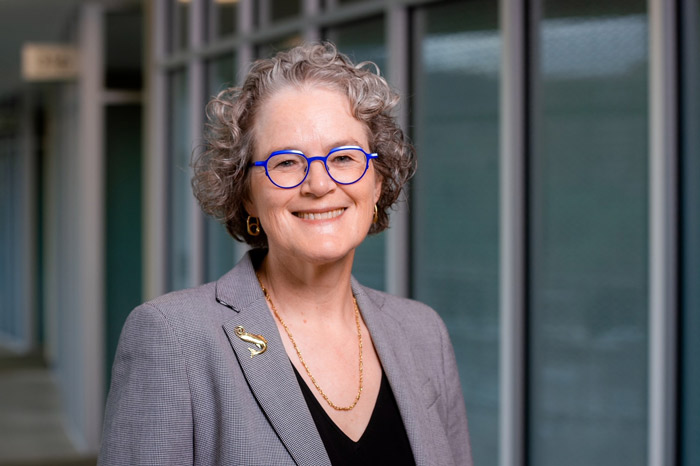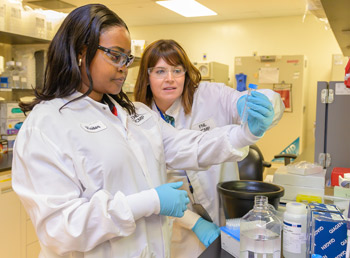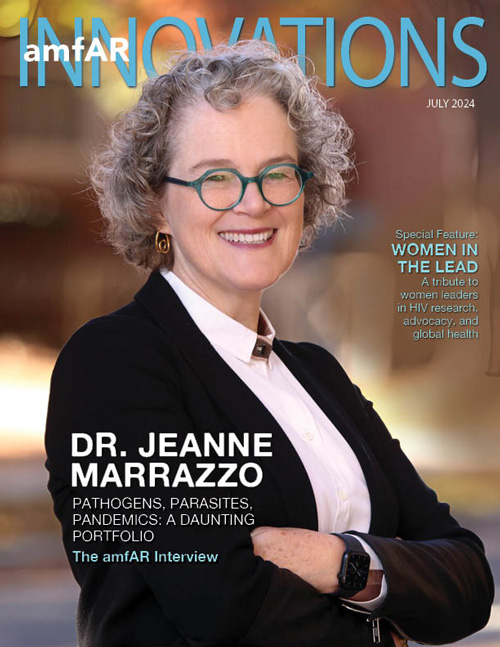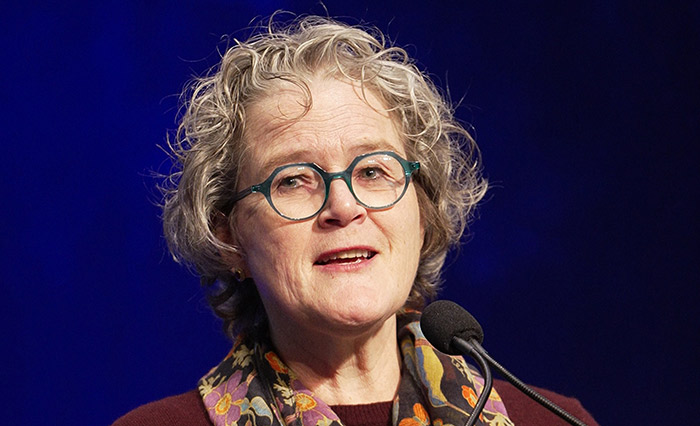Pathogens, Parasites, Pandemics: A Daunting Portfolio
The amfAR Interview: Jeanne Marrazzo, MD, MPH

In the fall of 2023, Dr. Jeanne Marrazzo succeeded Dr. Anthony Fauci as director of the National Institute of Allergy and Infectious Diseases (NIAID) at the U.S. National Institutes of Health. She oversees a $6.6 billion budget that supports research to advance the understanding, diagnosis, treatment, and prevention of infectious, immunologic, and allergic diseases.
Dr. Marrazzo is internationally recognized for her research and education efforts in the field of sexually transmitted infections, especially as they affect women’s health. Among her primary research interests is the prevention of HIV infection using biomedical interventions, including pre-exposure prophylaxis (PrEP) and microbicides. She is the author, coauthor, or editor of more than 250 scientific publications. Prior to NIAID, Dr. Marrazzo was Director of the Division of Infectious Diseases at the University of Alabama at Birmingham.

Innovations editor Andrew McInnes spoke with Dr. Marrazzo about her approach to the job, her aspirations, and the challenges she faces.
NIAID is in the midst of a strategic planning process for the next five years. In which directions would you like to take the institute in the future?
One thing is pandemic preparedness. I am still very anxious about the threat of another pandemic, as I think all infectious disease people are. That could come in the form of further evolution of SARS CoV-2 [the virus that causes COVID-19]. We know the variants continue to evolve. Or it could come in the form of avian influenza. This phenomenon we’re seeing now of highly pathogenic avian flu in dairy cows is a harbinger of spillover of these viruses from migratory birds in particular into settings that are much more associated with human interactions. So being prepared for those is really critical.
We were very lucky with the SARS CoV-2 response because we had done so much structural work on that family of viruses—coronaviruses. We don’t really have that luxury for many viruses that have pandemic potential. So that’s a really big priority and requires working globally to make sure we know what’s going on, whether there are emerging illnesses or other signals that things are happening.
“I’m excited about products such as a dual prevention pill that has an antiretroviral and a contraceptive.”
Also we cannot stop our efforts to end the HIV epidemic. I see it as starting to strategically deploy the tools that we are increasingly developing: long-acting agents for both treatment and prevention, as well as new prevention tools. We need to look at alternative biomedical prevention and continue to double down on vaccines. There are some hopeful signs in the vaccine world in the last couple of years so I do think we’ll get there. And I’m really hopeful that we’ll increase our success in preventing mother-to-child transmission because there are still about 130,000 new infant HIV transmissions annually—a lot of them in non-PEPFAR countries where they don’t have access to antiretrovirals.
The third thing I think about a lot is that we at NIAID have been very pathogen focused. People have their disease—their virus, bacteria, or parasite. But really, people are people who get affected by many conditions, and with people—especially people with HIV—living much longer, healthy lives, they are experiencing a lot of concomitant conditions that we are interested in too: TB is the best example and the biggest killer of people living with HIV worldwide. So I am excited about the TB agenda. We are really doing well with new drugs, long-acting drugs, and for the first time I think there is moderate hope for a good vaccine.
Syndemics, or overlapping epidemics, have gained currency in the wake of the opioid epidemic, COVID-19, Mpox, and their relationship to HIV and other sexually transmitted infections. What opportunities do you see to foster cross-collaboration in infectious disease work at NIAID?

I think it’s time we start thinking about that purposefully. One of the ways I’ve been trying to do it is to start talking about this ‘whole person’ concept. Yes, we study diseases, but we want to make life better for people living with infections. And that is a different thing. You do have to start in the lab. But you also have to know how to manage the condition in people’s bodies. And in some ways, that’s just not a biological approach, it’s a biobehavioral approach.
We know that we can make a perfect pill, but there’s no magic pill because not everybody will take the pill. Same thing with a vaccine … and with oral PrEP. If we could get it to everybody at scale and everybody would use it, we could theoretically really affect the trajectory of HIV.
So I think the idea of fostering interdisciplinary approaches to infections that are common in, for example, people living with HIV, who are more likely to get TB, is a start. Our people working in the Division of AIDS have gotten very involved in TB research, as well as STI research, and increasingly, hopefully, we’ll be getting involved in things like malaria. So I think it’s an exciting time, but it has to be articulated as a goal.
We’ve come a long way in addressing HIV and STIs with innovations such as long-acting agents and Doxy PEP. What other types of innovations do you see down the road that may be game changers?
One thing I like to think about is developing products that people want to use and why they want to use them. We know that in the studies of oral PrEP in cisgender women, their reports of using the study products [oral tenofovir] were actually quite high, but when you looked at the biological evidence, they clearly weren’t telling us the truth. The reasons we have uncovered in conversation with many of those participants largely have to do with the reasons people stay in these studies—because they get care, they get contraception, and they get STI screening.
“We know that we can make a perfect pill, but there’s no magic pill because not everybody will take the pill.”
If people want contraception, why not think about a multipurpose prevention product? I’m excited about products such as a dual prevention pill, being looked at by the MATRIX Project, that has an antiretroviral and a contraceptive.
We also know that the dapivirine ring—a vaginal ring that you can put in once a month—has had very good acceptability in several studies. What if you offered a ring that was a combination contraceptive vaginal ring along with an antiretroviral for women who wanted to prevent unintended pregnancy, and not get HIV? It would be fantastic if we had a product that could prevent STIs too. That would be the ultimate multipurpose prevention technology. I’m thinking about these things as a way to enhance their appeal, usability, and accessibility.
I’ve also remained of the opinion that on-demand products, particularly for anal sex, are really important. Not everybody is prepared to be kind of loaded up on whatever pharmaceutical agent we know works to prevent HIV. Maybe having a rectal douche, having a vaginal gel, having something that people can use on the spot, especially if they can’t control when they’re going to be exposed because they can’t control when they’re having sex. I think that’s an important piece of the puzzle that we can’t forget.

Click here to read more interviews, articles and features from the latest edition of Innovations.
Is the inclusion of women in clinical studies for HIV and other diseases improving and getting closer to where it should be?
I think we’re doing much better. If you look at our clinical trials across the Institute, over 50% of our participants are women. That’s good because we have some studies that are specifically for MSM and transgender women, and obviously you want to look at trans and cis women. I think that investigators in the field have a better appreciation for this, and they’re also being held to standards.
But we have a ways to go before we routinely ensure that products are studied expeditiously in pregnant women, women not contracepting who could potentially get pregnant, or women who are breastfeeding.
“There is still a lack of understanding of what we do and what role we have had in saving lives.”
amfAR’s primary research focus for the past 15 years or so has been on the pursuit of a cure for HIV. Where do you see the HIV cure research field heading in the next 5-10 years?

We obviously sponsor the Martin Delaney Collaboratories for HIV Cure Research and it’s an incredible group of people. I think that progress in defining the HIV reservoir, the extent of the reservoir, and what we need to do to get to the reservoir with therapies is getting much more advanced. It’s very difficult work because the reservoir is so tricky and so small, so latent, but I think eradicating or controlling residual virus first in animal models but also in humans ultimately is going to be something to watch in the next couple of years.
I do think that we have to continue to talk about this with the community. I met the London Patient, Adam Castillejo, at CROI this year. He talked about this concept of, is cure for everyone? Will a cure really be taken up by people? Will it be different for different groups of people? He presented some interesting anecdotal data that said that people in different countries, different social settings, might feel differently about a cure. I like the idea of continuing to push on the science side and talk about what the societal implications are.
The other thing is CRISPR and gene editing. That field is moving so quickly. I just met with Jennifer Doudna and her group this past week. They’re trying to figure out ways to take what now is almost impossibly expensive—for example, the sickle cell cure, which costs a couple of million dollars—to something where you could actually deliver a product as a pill or a single injection. The technology is getting very exciting. I don’t think you can worry about costs because, if it works dramatically, then we’ll figure out how to scale it.
You’ve been in the director’s job a little over six months now. You oversee a $6+ billion budget and a vast portfolio of research projects and priorities. What is the biggest challenge you face as director of NIAID?
You said challenge, so I’m only going to list one, but it’s a really critical one. And that is maintaining our budget in the face of a climate that is all too receptive to misinformation and blame. So, as I’m sure you know from the press, my predecessor [Anthony Fauci, MD] has taken and continues to take a huge amount of negative energy for what he championed during the pandemic and what he did. And that feeling persists and there is still a lack of understanding of what we do and what role we have had in saving lives. So telling that story, telling it to the right people, making sure the people who keep us solvent and funded know that so that we can continue to support our investigators and our communities—that’s the big job.
Share This:
